Amritsar

Amritsar district (Doabi:ਅੰਮ੍ਰਿਤਸਰ ਜ਼ਿਲਾ) is one of 20 districts in the state of Punjab in West India. It has a population of 3,074,207 (2001 Indian census) and covers an area of 5075 km². The city of Amritsar is headquarters of this district.
HISTRY OF AMRITSAR
During British Rule Amritsar was part of Lahore Division and was administratively subdivided into 3 tehsils namely - Amritsar, and Ajnala. Tarn Taran has itself formed into a district headquarters.[1] However as part of the partition of India in 1947 Amritsar district was separated from the rest of the division and awarded to India. During the partition period, the Muslim population of the district, some 46%, left for Pakistan while Hindus and Sikhs from Pakistan migrated in the opposite direction.
During the Last Sikh Raj of Panjab Amritsar District was known as Patti Pargana. It was in 1849 During the annexation of Panjab Sikh Kingdom that Amritsar District Was Created.
HISTRY OF AMRITSAR
During British Rule Amritsar was part of Lahore Division and was administratively subdivided into 3 tehsils namely - Amritsar, and Ajnala. Tarn Taran has itself formed into a district headquarters.[1] However as part of the partition of India in 1947 Amritsar district was separated from the rest of the division and awarded to India. During the partition period, the Muslim population of the district, some 46%, left for Pakistan while Hindus and Sikhs from Pakistan migrated in the opposite direction.
During the Last Sikh Raj of Panjab Amritsar District was known as Patti Pargana. It was in 1849 During the annexation of Panjab Sikh Kingdom that Amritsar District Was Created.
Barnala

Barnala (Doabi:ਬਰਨਾਲਾ ਜ਼ਿਲਾ) is one of the district of Indian state of Punjab. Earlier Barnala was part of Sangrur district , but now Barnala is a separate district.
It is a centrally located district bordered by Ludhiana district on the north, Moga district on northwest, Bathinda district on west and by Sangrur district on all other sides
It is a centrally located district bordered by Ludhiana district on the north, Moga district on northwest, Bathinda district on west and by Sangrur district on all other sides
Bathinda
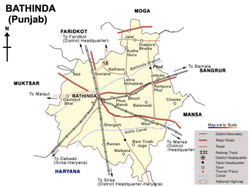
Bathinda district (Doabi:ਬਠਿੰਡਾ ਜ਼ਿਲਾ) is in Punjab, India. The districts encompasses an area of 3,344 square kilometres. It is bounded by Faridkot district on the north, Mukatsar district on the west, Barnala and Mansa districts on the east, and the state of Haryana on the south. Bathinda is cotton producing belt of Punjab.
Bathinda is divided into the 3 tehsils of Bathinda,Rampurphul, and Talwandisabo. These tehsils are further divided into the 8 blocks of Bathinda, Sangat, Nathana,Rampura, Phul, Maur, Bhagta Bhaika and Talwandisabo.
Bathinda is divided into the 3 tehsils of Bathinda,Rampurphul, and Talwandisabo. These tehsils are further divided into the 8 blocks of Bathinda, Sangat, Nathana,Rampura, Phul, Maur, Bhagta Bhaika and Talwandisabo.
Ferozpur

Ferozepur district (Doabi:ਫੇਰੋਜ਼ੇਪੁਰ ਜ਼ਿਲਾ) is one of the twenty districts in the state of Punjab in North-West Republic of India.
It comprises an area of 11,142 km². The surface is level, with the exception of a few sand-hills in the south and south-east. The country consists of two distinct tracts that are liable to annual fertilizing inundations from the Sutlej, the only river, which runs along the north-western boundary. The principal crops are wheat, barley, millet, gram, pulses, oil seeds, cotton, tobacco, &c. The manufactures are of the humblest kind, consisting chiefly of cotton and wool-weaving and are confined entirely to the supply of local wants. The other important towns and sea of commerce are Zira, Fazilka, Abohar, Dharmkot, Mallanwalla, Talwandi Bhai and Jalalabad. Geographically it is the biggest district of Punjab. Owing principally to the dryness of its climate (apart from annual rains in September and October), Ferozepur has the reputation of being an exceptionally healthy district. It has second most rice mills in Punjab and used to be big trade centre before partition of India and Pakistan.
Firozpur city is the capital of this District. The Firozpur Cantonment adjoining Ferozepur city combines with the city to give the district its most urban hub. It is one of the oldest cantonments in India
It comprises an area of 11,142 km². The surface is level, with the exception of a few sand-hills in the south and south-east. The country consists of two distinct tracts that are liable to annual fertilizing inundations from the Sutlej, the only river, which runs along the north-western boundary. The principal crops are wheat, barley, millet, gram, pulses, oil seeds, cotton, tobacco, &c. The manufactures are of the humblest kind, consisting chiefly of cotton and wool-weaving and are confined entirely to the supply of local wants. The other important towns and sea of commerce are Zira, Fazilka, Abohar, Dharmkot, Mallanwalla, Talwandi Bhai and Jalalabad. Geographically it is the biggest district of Punjab. Owing principally to the dryness of its climate (apart from annual rains in September and October), Ferozepur has the reputation of being an exceptionally healthy district. It has second most rice mills in Punjab and used to be big trade centre before partition of India and Pakistan.
Firozpur city is the capital of this District. The Firozpur Cantonment adjoining Ferozepur city combines with the city to give the district its most urban hub. It is one of the oldest cantonments in India
Gurdaspur

Gurdaspur district (Doabi:ਗੁਰਦਸਪੂਰ ਜ਼ਿਲਾ) is a district in the state of Punjab, situated in the northwest part of the Republic of India. Gurdaspur is the district headquarters. It internationally borders Narowal District of the Pakistani Punjab, Kathua District of the disputed territory of Indian-administered Kashmir, the Punjab districts of Amritsar and Hoshiarpur, and Chamba and Kangra districts of Himachal Pradesh. Two main rivers Beas and Ravi passes through the district. The Mughal emperor Akbar is said to have been enthroned in a garden near Kalanaur, a historically important town in the district.[1]. The district is at the foothills of the Himalayas.
The current member of Parliament of Gurdaspur is Pratap Singh Bajwa .
The current member of Parliament of Gurdaspur is Pratap Singh Bajwa .
Faridkot

Faridkot district (Doabi:ਫਰੀਦਕੋਟ ਜ਼ਿਲਾ) is one of the twenty districts in the state of Punjab in North-West Republic of India. According to Punjab's Geo-Area, Faridkot is a Malwa District. It is one of the biggest cotton markets in South-East Asia. The name 'Faridkot' is derived from Baba Farid, a god-lover who wanted see the God. Faridkot was feudlist province under British rule, but now it is a district in Punjab in independent India. Few part of District Moga & Mukatsar were also taken from Faridkot.
Fatehgarh Sahib
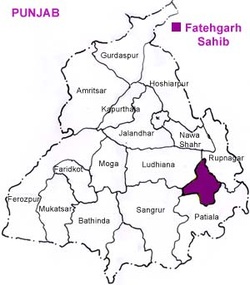
Fatehgarh Sahib district (Doabi:ਜ਼ਿਲਾ ਫ਼ਤਿਹਗੜ੍ਹ ਸਾਹਿਬ), Hindi: फ़तेगढ़ साहिब ज़िला) is one of the twenty districts in the state of Punjab in North-West Republic of India, with its headquarters in the city of Fatehgarh Sahib.
District of Fatehgarh Sahib came into existence on 13 April 1992, Baisakhi Day, deriving its name 'Fatehgarh Sahib' from Sahibzada Fateh Singh, the youngest son of 10th Guru Gobind Singh, who were bricked alive by the orders of Suba Sirhind, Wazir Khan in 1705 [1], and the place is now the site a famous 'Gurudwara Fatehgarh Sahib'.[2]
District of Fatehgarh Sahib came into existence on 13 April 1992, Baisakhi Day, deriving its name 'Fatehgarh Sahib' from Sahibzada Fateh Singh, the youngest son of 10th Guru Gobind Singh, who were bricked alive by the orders of Suba Sirhind, Wazir Khan in 1705 [1], and the place is now the site a famous 'Gurudwara Fatehgarh Sahib'.[2]
Hoshiarpur
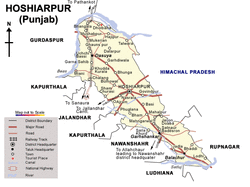
The area of present Hoshiarpur was also part of Indus Valley Civilization. Recent excavations at various sites in the district have revealed that the entire area near the Shivalik foothills was selected for habitation not only by the early palaeolithic man but also by those in the protohistoric and historic periods. In the explorations, seven early Stone Age sited a Atbarapur, Rehmanpur and Takhni, 30-40 km north of Hoshiarpur District in the foothills of Shivalik, have been discovered where the stone artifacts have been found. Besides these excavations, among the archaeological remains in the Hoshiarpur District, the remains of temples at Dholbaha, 24 km north of Hoshiarpur, and especially the local legends throw valuable light on the ancient history of the district. The archaeological explorations made during the recent years have revealed the antiquity of the Hoshiarpur District to the Harappan Period. The sculptures and other findings excavated from Dholbaha pertain to the Gurjara Prathihara Period ( C-800-1100 A D). In the 10th Century A D Shiwalik areas came under the influence of Pratiharas. During that period, the art of the local tribes took a definite shape. In AD 965, Jaipal came to the throne and thus the Hindu Shahi style penetrated into the valley of Dholbaha. In AD 988, the rulers of Parmaras remained paramount power up to AD 1260. It is said that before the first Muhammadan invasion in 1174AD, Raja Shankar Dass built a fort on the site of the present town of Garhshankar, but it was taken by Mahmud Ghazni. After that this region was invaded by many Muslim rulers time to time and later on in 19th century was under Sikh rule before being occupied by Britishers until 1947.
Hoshiarpur was known as Chanchadhari-city between river vyas and Sutlej in old Hindu scriptures. This first account of this place was found in Hindu mythology, related to a story as it is said that many thousands of years ago the Lord of the universe and God of the three Lokas, Lord Sri Vishnu Narayana was having a sleep on the bed of the Cobra. The Goddess Lakshmi was respectfully nursing his feet. At the very same time, the Maharishi Bhrigu presented himself to the Vaykunth Loka at the entrance. Two Doorkeepers – Jai and Vijay - were standing at the entrance to the Vaykunth Loka. First, they welcomed Bhrigu Rishi, but then they told him to wait and not to enter right away, since Lord Sri Vishnu was sleeping. Not being allowed entrance to Lord Sri Vishnu Narayana, the Maharishi Bhrigu got very angry and said to Jai and Vijay: "By stopping the Maharishi Bhrigu you have insulted the most great Brahmin soul. Due to that you can get a curse, which will force you to be reborn on the Earth at least three times."While listening to this threat from Maharishi Bhrigu, Jai and Vijay both bended down their heads and were very silent. Now the Bhrigu Rishi could enter the door without anybody stopping him. The Maharishi Bhrigu then entered the place where Lord Sri Vishnu Narayana was sleeping with Goddess Lakshmi at his feet. When Bhrigu Rishi saw this, he became full of anger, because he thought that Lord Vishnu was not really sleeping, but only pretending to sleep just to insult him. This was the time, when the Maharishi Bhrigu with his right leg kicked the chest of Lord Sri Vishnu. When he was hit Lord Vishnu opened his eyes and stood up. Lord Vishnu was astonished to see the Bhrigu Rishi standing there. So he bended down his head, folded his hands, and said to Bhrigu Rishi: "My Lord, my chest is the strongest thing in the world, like a mountain, but your feet are so soft. Maybe you got hurt while kicking me. So please forgive me for that."While listening to the words of Lord Vishnu, the Bhrigu Rishi got very calm and felt very guilty, and he asked the God please to forgive him. As all this happened, Lakshmi, the Goddess of wealth, got very angry, and she said to Maharishi Bhrigu: "By behaving this badly towards my husband, you have insulted me. Therefore I now give a curse, so that you and your fellow Brahmins will always live in poverty begging for your living. I will never come to your home."After listening to this the Bhrigu Rishi said: " Hey Lakshmi! Whatever crime I did was in anger, and I have already asked the Lord Sri Vishnu to forgive me. By not thinking very nicely, you have now given this curse to me and my fellow Brahmins. But anyway, what has happened has happened. I will now write a Jyotish Grantha, from which the Brahmins can predict all about the past, present and future of every person in the world. They will get good knowledge as well as good earnings from this. They will be able to earn their livelihood. And this way you have got to come to their home anyhow!"Having said this Maharishi Bhrigu went back to his ashram, and wrote his book known as "Bhrigu Samhita" which contains the life-stories of the past, present and future of all the people in the world on the basis of their Janma-kundalies. First of all, Bhrigu Rishi taught the principles of this Grantha to his own son and disciple Shukra. And from the lips of Shukra it was little by little distributed to the Brahmins all over the world. The ashram of Bhrigu rishi was in Hoshiarpur and the Bhrigu samhita was placed in this city. In ancient India, it was very important center for learning astrology. Many people use to come here in search of the predictions about their life. But with invasions of non Hindu rulers, the part of Bhrigu Samhita was destroyed, relocated or looted. Still today, there are many astrologers describing themselves descendent's of Bhrigu are doing business and claim to possess part of Bhrigu Samhita written on leaves. And this was the main reason that Hoshiarpur was famous in ancient and medieval India.
Hoshiarpur was known as Chanchadhari-city between river vyas and Sutlej in old Hindu scriptures. This first account of this place was found in Hindu mythology, related to a story as it is said that many thousands of years ago the Lord of the universe and God of the three Lokas, Lord Sri Vishnu Narayana was having a sleep on the bed of the Cobra. The Goddess Lakshmi was respectfully nursing his feet. At the very same time, the Maharishi Bhrigu presented himself to the Vaykunth Loka at the entrance. Two Doorkeepers – Jai and Vijay - were standing at the entrance to the Vaykunth Loka. First, they welcomed Bhrigu Rishi, but then they told him to wait and not to enter right away, since Lord Sri Vishnu was sleeping. Not being allowed entrance to Lord Sri Vishnu Narayana, the Maharishi Bhrigu got very angry and said to Jai and Vijay: "By stopping the Maharishi Bhrigu you have insulted the most great Brahmin soul. Due to that you can get a curse, which will force you to be reborn on the Earth at least three times."While listening to this threat from Maharishi Bhrigu, Jai and Vijay both bended down their heads and were very silent. Now the Bhrigu Rishi could enter the door without anybody stopping him. The Maharishi Bhrigu then entered the place where Lord Sri Vishnu Narayana was sleeping with Goddess Lakshmi at his feet. When Bhrigu Rishi saw this, he became full of anger, because he thought that Lord Vishnu was not really sleeping, but only pretending to sleep just to insult him. This was the time, when the Maharishi Bhrigu with his right leg kicked the chest of Lord Sri Vishnu. When he was hit Lord Vishnu opened his eyes and stood up. Lord Vishnu was astonished to see the Bhrigu Rishi standing there. So he bended down his head, folded his hands, and said to Bhrigu Rishi: "My Lord, my chest is the strongest thing in the world, like a mountain, but your feet are so soft. Maybe you got hurt while kicking me. So please forgive me for that."While listening to the words of Lord Vishnu, the Bhrigu Rishi got very calm and felt very guilty, and he asked the God please to forgive him. As all this happened, Lakshmi, the Goddess of wealth, got very angry, and she said to Maharishi Bhrigu: "By behaving this badly towards my husband, you have insulted me. Therefore I now give a curse, so that you and your fellow Brahmins will always live in poverty begging for your living. I will never come to your home."After listening to this the Bhrigu Rishi said: " Hey Lakshmi! Whatever crime I did was in anger, and I have already asked the Lord Sri Vishnu to forgive me. By not thinking very nicely, you have now given this curse to me and my fellow Brahmins. But anyway, what has happened has happened. I will now write a Jyotish Grantha, from which the Brahmins can predict all about the past, present and future of every person in the world. They will get good knowledge as well as good earnings from this. They will be able to earn their livelihood. And this way you have got to come to their home anyhow!"Having said this Maharishi Bhrigu went back to his ashram, and wrote his book known as "Bhrigu Samhita" which contains the life-stories of the past, present and future of all the people in the world on the basis of their Janma-kundalies. First of all, Bhrigu Rishi taught the principles of this Grantha to his own son and disciple Shukra. And from the lips of Shukra it was little by little distributed to the Brahmins all over the world. The ashram of Bhrigu rishi was in Hoshiarpur and the Bhrigu samhita was placed in this city. In ancient India, it was very important center for learning astrology. Many people use to come here in search of the predictions about their life. But with invasions of non Hindu rulers, the part of Bhrigu Samhita was destroyed, relocated or looted. Still today, there are many astrologers describing themselves descendent's of Bhrigu are doing business and claim to possess part of Bhrigu Samhita written on leaves. And this was the main reason that Hoshiarpur was famous in ancient and medieval India.
Jalandhar
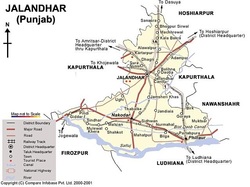
Jalandhar ( ਜਲੰਧਰ ) known as Jullundur, is an ancient city in Jalandhar District in the state of Punjab, India. It has an urban population of almost a million, and another million live in the rural areas outside the city.
The city is well known for its production of traditional Indian Sweets, sports equipment, leather goods and rubber goods, and auto parts. Many major leather manufacturers are based there, the largest being Gee Kay International who supply a variety of leather products ranging from garments to tool bags around the world. Many major sports equipment manufacturers such as BAS, Bhaseen Sports (Baspo),Soccer International, Spartan and F.C. Sondhi are based there. In sports goods, some the world's best known equipment and products for football, cricket, and hockey are made in Jalandhar. Major sports giants such as Adidas, Reebok, Dunns, and Mitre outsource from Jalandhar. Current mayor is Rakesh Rathore
Jalandhar was a hub of green revolution of India in early 60s. Dr. Dilbag Singh Athwal, world renowned scientist in plant breeding, developed India's first high yield wheat KALYAN. The wheat he name afer his native village Kalyanpur 6 miles (9.7 km) southwest of city of Jalandhar. Later Dr. Athwal headed International Rice Research Institute, International Agricultural Development Service etc. Dr. Athwal took early retirement from his position as senior vice president Rockefeller Institute. The village Kalyanpur (now part of Jalandhar city) have produced prominent scientist including Dr. Raghbir Singh, Dr. Rajbir Kaur, Dr. Iqbal Singh Athwal.
Jalandhar is the world's biggest manufacturer of leather tool pouches and aprons with major American and European customers buying from factories in Jalandhar. \
Jalandhar being the NRI Belt and having large number of marriage palaces, Jalandhar has a huge consumption of fresh flowers, with world renowned florists like Meera Florist providing the service. Recently Ludhiana district have developed more marriage palaces, and have American based companies because being the second largest district of NRI residents the Ludhiana city is the hub of Punjab.
Jalandhar is also famous for its surgical tool industry. Jalandhar produces a large number of surgical tools. Big companies like Camlin outsource their production here. The city boasts of having the largest number of hospitals in Asia. A place called Basti Sheikh has many cottage projects which run without any help of the Punjab government.[citation needed]
Jalandhar also has the biggest printing industry in India. Major publishing and advertising companies like, MBD, Aay Bee advertisers have their main offices in Jalandhar.
Jalandhar is seeing an increasing growth of technology investment, with headquarters and operational centres from the likes of Dell and Microsoft being set up. Jalandhar is also the home of the headquarters of Kayako.
Jalandhar is famous for its sports industry, but very few know the name of Hindustan Hydraulics who pioneered the manufacturing of high-tech CNC machines for sheet metal industry. The company has its customers not only in India but in countries like Germany, Holland, USA who are better known for the manufacturing of machine tools around the world.
Jalandhar is also quite known for its electrical goods industry. Manufacturers like Standard Switchgears and Apex Electricals, located in Jalandhar, have been producing world-class electrical switchgears for over three decades.
Kapurthala
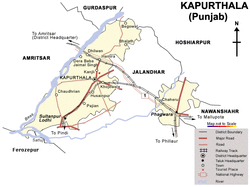
Kapurthala is a city in Punjab state of India. It is the administrative headquarters of Kapurthala District. It was the former capital of princely state of British India of the same name. The secular and aesthetic mix of the city with its prominent buildings based on French and Indo-Saracenic style of architecture self-narrate its princley past and once earned this small town in the Punjab the sobriquet of Paris of Punjab.
The history of the Town of Kapurthala goes back as early as the 11th Century when it's said to have been founded by Rana Kapur, a scion of the ruling house of Jaisalmer (Rajasthan). The present royal family of Kapurthala is descended from Nawab Jassa Singh Ahluwalia, a contemporary of Nadir Shah and Ahmad Shah, who by his intelligence and bravery made himself the leading Sikh of his day. At one time it held possessions on both sides of the Sutlej, and also in the Bari Doab. The cis-Sutlej estates and scattered tracts in the Bari Doab were forfeited owing to the hostility of the chief in the First Sikh War; but the latter were afterwards restored in recognition of the loyalty of Raja Randhir Singh during the mutiny of 1857, when he led a contingent to Oudh which did good service. He also received a grant of land in Oudh, 700 m² in extent, yielding a gross rental of 89,000. In Oudh, however, he exercises no sovereign powers, occupying only the status of a large landholder, with the title of Raja-i-Rajagan.
Raja Sir Jagatjit Singh, K.C.S.I., was born in 1872, succeeded his father in 1877, and attained his majority in 1890. During the Tirah expedition of 1897-98 the Kapurthala imperial service infantry took a prominent part. The territory is crossed by the railway from Jalandhar to Amritsar. The state has a large export trade in wheat, sugar, and cotton. The hand-painted cloths and metal-work of Phagwara are well known. The town of Kapurthala is approximately 20 Kilometers from Jalandhar.
The history of the Town of Kapurthala goes back as early as the 11th Century when it's said to have been founded by Rana Kapur, a scion of the ruling house of Jaisalmer (Rajasthan). The present royal family of Kapurthala is descended from Nawab Jassa Singh Ahluwalia, a contemporary of Nadir Shah and Ahmad Shah, who by his intelligence and bravery made himself the leading Sikh of his day. At one time it held possessions on both sides of the Sutlej, and also in the Bari Doab. The cis-Sutlej estates and scattered tracts in the Bari Doab were forfeited owing to the hostility of the chief in the First Sikh War; but the latter were afterwards restored in recognition of the loyalty of Raja Randhir Singh during the mutiny of 1857, when he led a contingent to Oudh which did good service. He also received a grant of land in Oudh, 700 m² in extent, yielding a gross rental of 89,000. In Oudh, however, he exercises no sovereign powers, occupying only the status of a large landholder, with the title of Raja-i-Rajagan.
Raja Sir Jagatjit Singh, K.C.S.I., was born in 1872, succeeded his father in 1877, and attained his majority in 1890. During the Tirah expedition of 1897-98 the Kapurthala imperial service infantry took a prominent part. The territory is crossed by the railway from Jalandhar to Amritsar. The state has a large export trade in wheat, sugar, and cotton. The hand-painted cloths and metal-work of Phagwara are well known. The town of Kapurthala is approximately 20 Kilometers from Jalandhar.
Ludhiana
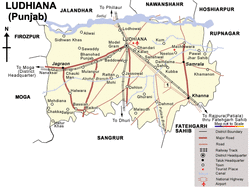
Ludhiana district (Doabi:ਲੁਧਿਆਣਾ ਜ਼ਿਲਾ) is one of the 20 districts in the state of Punjab in North-West Republic of India. Ludhiana city which is district headquarters is the hub of industry in Punjab. The main industries are bicycle parts and hosiery. Ludhiana is the biggest city of Indian Punjab.
History
Ludhiana gets its name from the Lodhi Dynasty, which is believed to have founded the city in 1480. During the reign of the Mughal emperor Akbar the area formed part of the Sarkar or Sirhind. In the latter period of Mughal rule the western part of the district was leased to the Rais of Raikot, by the early eighteen century they had become semi independent of the Mughals. In 1747 Ahmad Shah Durrani invaded and battled the imperial army near Khanna, although the Mughals were able to stop Ahmad Shah - his subsequent invasions weakened the Mughals, which allowed the Rais to take control of Ludhiana town in 1760.[1] Chakar, Talwandi Rai in 1478 AD, Raikot in 1648 AD and Jagraon in 1688 AD were founded by the Rai family of Raikot. Ref-Ludhiana Dist. Gazetteer 1888-89&1904. Chiefs of Punjab 1890,1909 & 1940
During the reign of Maharaja Ranjit Singh, Ludhiana became an important British cantonment. Initially, in 1805, Ranjit Singh occupied Ludhiana. However, in 1809, the British decided to curb his advance eastward and sent troops to confront him. Ranjit Singh was forced to sign the treaty of 'perpetual friendship' with the British, which confined his activities to the right bank of the Sutlej. British troops were permanently stationed in Ludhiana and the Cis-Sutlej states came under British protection.
According to the 1901 census, Hindus numbered 269,076, or 40 per cent of the total; Muslims, 235,937, or 35 per cent; and Sikhs, 164,919, or 24 per cent.[2] In 1947 due to violence and strife between the communities the Muslim population were compelled to leave for Pakistan.[3]
History
Ludhiana gets its name from the Lodhi Dynasty, which is believed to have founded the city in 1480. During the reign of the Mughal emperor Akbar the area formed part of the Sarkar or Sirhind. In the latter period of Mughal rule the western part of the district was leased to the Rais of Raikot, by the early eighteen century they had become semi independent of the Mughals. In 1747 Ahmad Shah Durrani invaded and battled the imperial army near Khanna, although the Mughals were able to stop Ahmad Shah - his subsequent invasions weakened the Mughals, which allowed the Rais to take control of Ludhiana town in 1760.[1] Chakar, Talwandi Rai in 1478 AD, Raikot in 1648 AD and Jagraon in 1688 AD were founded by the Rai family of Raikot. Ref-Ludhiana Dist. Gazetteer 1888-89&1904. Chiefs of Punjab 1890,1909 & 1940
During the reign of Maharaja Ranjit Singh, Ludhiana became an important British cantonment. Initially, in 1805, Ranjit Singh occupied Ludhiana. However, in 1809, the British decided to curb his advance eastward and sent troops to confront him. Ranjit Singh was forced to sign the treaty of 'perpetual friendship' with the British, which confined his activities to the right bank of the Sutlej. British troops were permanently stationed in Ludhiana and the Cis-Sutlej states came under British protection.
According to the 1901 census, Hindus numbered 269,076, or 40 per cent of the total; Muslims, 235,937, or 35 per cent; and Sikhs, 164,919, or 24 per cent.[2] In 1947 due to violence and strife between the communities the Muslim population were compelled to leave for Pakistan.[3]
Mansa
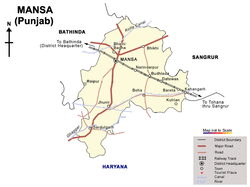
Mansa district (Doabi:ਮਾਨਸਾ ਜ਼ਿਲਾ) is situated in Punjab, India. The main town is Mansa. It was formed on 13 April 1992 from the erstwhile Bathinda district.
The district has an area of 2174 km² and a population of 688,630 (2001 census), with a population density of 317 persons per km². The district is roughly triangular in shape, and is bounded on the northwest by Bathinda district, on the northeast by Sangrur district, and on the south by Haryana state. The district is divided into three tehsils, Budhlada, Mansa, and Sardulgarh. The Ghaggar River flows through Sardulgarh tehsil in the southwestern corner of the district. It is situated on the rail line between Bathinda-Jind-Delhi section and also situated on the Barnala-Sardulgarh-Sirsa road.
The population is Punjabi-speaking and is wedded to the culture of the Malwa belt of Punjab.
History
Mansa district has pre-harappan,harappan and late harappan sites which prove that region was inhabited by people as late as 2800 BC.According to the gazetteer of bathinda district harappan sites in this region were mapped by archaeologist B.B Lal in the year 1981-82 Harappan sites found in mansa district Pre-Harappan Period 1. Alipur Manoran 2. Baglian-de-Theh 3. Bare 4. Chhoti Mansa 5. Dhalewan 6. Gurni Kalan 7. Hasan Pur 8. Hirke 9. Lakhmir Wala 10. Naiwala Theh Harappan Period 1. Alipur Mandran 2. Baglian-de-Theh 3. Dalewan 4. Chhoti Mansa 5. Gurni Kalan 6. Hassanpur 7. Hirke 8. Karanpura 9. Lakhmir Wala 10. Lallian Wali 11. Lalu Wala 12. Ali-Da-Theh 13. Naiwala Theh Late Harappan Period 1. Alipur Mandran 2. Chhoti Mansa 3. Ali-Da-Theh 4. Bare 5. Bhikhi 6. Danewala 7. Dalewala 8. Nehriwala 9. Sahnewali. The town of mansa is said to have been founded by Bhai Gurdas who hailed from Dhingar, District. Mansa. He is said to have married a member of the Dhaliwal Jat Sikh clan at this place. Once he came to his in-laws to take his wife along with him but they refused to send her. At this, Bhai Gurdas sat in meditation before the house of his in-laws. After some time, the parents of the girl agreed to send their daughter with Bhai Gurdas. But he refused to take her along with him, stating that he had now renounced the worldly way of life. In his memory, his Samadh was constructed where a fair is held every year in March-April. People in large numbers attend the fair and offer Laddus and gur at the Samadh. The town has been categorised as a Class ‘A’ municipality since 1952. During the late 80's many attacks on Hindus occurred by Sikh militants and was increasingly growing until army order was issued by the New Delhi government in the early 90's.
The district has an area of 2174 km² and a population of 688,630 (2001 census), with a population density of 317 persons per km². The district is roughly triangular in shape, and is bounded on the northwest by Bathinda district, on the northeast by Sangrur district, and on the south by Haryana state. The district is divided into three tehsils, Budhlada, Mansa, and Sardulgarh. The Ghaggar River flows through Sardulgarh tehsil in the southwestern corner of the district. It is situated on the rail line between Bathinda-Jind-Delhi section and also situated on the Barnala-Sardulgarh-Sirsa road.
The population is Punjabi-speaking and is wedded to the culture of the Malwa belt of Punjab.
History
Mansa district has pre-harappan,harappan and late harappan sites which prove that region was inhabited by people as late as 2800 BC.According to the gazetteer of bathinda district harappan sites in this region were mapped by archaeologist B.B Lal in the year 1981-82 Harappan sites found in mansa district Pre-Harappan Period 1. Alipur Manoran 2. Baglian-de-Theh 3. Bare 4. Chhoti Mansa 5. Dhalewan 6. Gurni Kalan 7. Hasan Pur 8. Hirke 9. Lakhmir Wala 10. Naiwala Theh Harappan Period 1. Alipur Mandran 2. Baglian-de-Theh 3. Dalewan 4. Chhoti Mansa 5. Gurni Kalan 6. Hassanpur 7. Hirke 8. Karanpura 9. Lakhmir Wala 10. Lallian Wali 11. Lalu Wala 12. Ali-Da-Theh 13. Naiwala Theh Late Harappan Period 1. Alipur Mandran 2. Chhoti Mansa 3. Ali-Da-Theh 4. Bare 5. Bhikhi 6. Danewala 7. Dalewala 8. Nehriwala 9. Sahnewali. The town of mansa is said to have been founded by Bhai Gurdas who hailed from Dhingar, District. Mansa. He is said to have married a member of the Dhaliwal Jat Sikh clan at this place. Once he came to his in-laws to take his wife along with him but they refused to send her. At this, Bhai Gurdas sat in meditation before the house of his in-laws. After some time, the parents of the girl agreed to send their daughter with Bhai Gurdas. But he refused to take her along with him, stating that he had now renounced the worldly way of life. In his memory, his Samadh was constructed where a fair is held every year in March-April. People in large numbers attend the fair and offer Laddus and gur at the Samadh. The town has been categorised as a Class ‘A’ municipality since 1952. During the late 80's many attacks on Hindus occurred by Sikh militants and was increasingly growing until army order was issued by the New Delhi government in the early 90's.
Moga
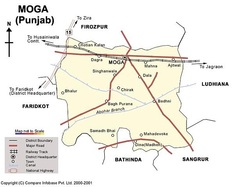
Moga district (Doabi:ਮੋਗਾ ਜ਼ਿਲਾ) is one of the Twenty districts in the state of Punjab in North-West Republic of India. It became the 17th district of Punjab State on 24 November 1995. It is also known as NRI district. Most Punjabi Non-resident Indians (NRIs) belong to rural areas of Moga District, who immigrated to the USA, the UK and Canada in the last 30-40 years. 40-45% of the population of NRIs from Canada, the US and the UK belong to Moga district. Moga District is among the largest producers of wheat and rice in Punjab, India. People from Moga City and Moga District belong to the Malwa culture.
Numerous attempts were previously made to make Moga a district but all were unsuccessful. Finally the then Chief Minister of Punjab S. Harcharan Singh Brar agreed to the public demand to make this a district on 24 November 1995.
Before this, Moga was the subdivision of Faridkot district. Moga town, the headquarters of the district, is situated on Ferozpur-Ludhiana road.
Contents [hide]
Numerous attempts were previously made to make Moga a district but all were unsuccessful. Finally the then Chief Minister of Punjab S. Harcharan Singh Brar agreed to the public demand to make this a district on 24 November 1995.
Before this, Moga was the subdivision of Faridkot district. Moga town, the headquarters of the district, is situated on Ferozpur-Ludhiana road.
Contents [hide]
Sahibzada Ajit singh nagar (mohali)
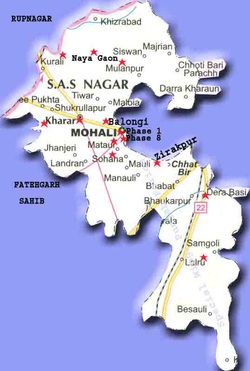
Mohali (Punjabi: ਮੋਹਾਲੀ, Hindi: मोहाली, mōhālī) is a city adjacent to Chandigarh, 18th District in Punjab, India. It is officially named after the eldest son of Guru Gobind Singh, Sahibzada Ajit Singh (SAS Nagar, or "House of Sahibzada Ajit Singh"). It along with Chandigarh and Panchkula form a part of the Chandigarh Tricity or Chandigarh Capital Region. It was earlier a part of the Rupnagar District, and was carved out into a separate district in the recent years.
Background
Mohali was conceived after the trifurcation of Punjab and its capital Chandigarh becoming a Union Territory in late 1966. Today, Mohali and Chandigarh are contiguous areas with only the boundary of Punjab and UT of Chandigarh dividing this area. The original plan of Mohali is in fact a mere extension of the road and design system of Chandigarh without any unique planning. The development earlier was only till Phase VII. The development of sectors and phases from Phase 8 onwards started in late 1980s, and the city got its own bus stand in Phase 8 in mid 1990s. In 2006, Mohali's population is near 200,000, approximately 1/5 of Chandigarh's. The region has been targeted by an increasing number of outsourcing IT companies, who look to capitalize on the rich investment opportunities the city offers.
Mohali and Panchkula are under the consideration of Punjab and now a days Mohali is a separate district of punjab.
Background
Mohali was conceived after the trifurcation of Punjab and its capital Chandigarh becoming a Union Territory in late 1966. Today, Mohali and Chandigarh are contiguous areas with only the boundary of Punjab and UT of Chandigarh dividing this area. The original plan of Mohali is in fact a mere extension of the road and design system of Chandigarh without any unique planning. The development earlier was only till Phase VII. The development of sectors and phases from Phase 8 onwards started in late 1980s, and the city got its own bus stand in Phase 8 in mid 1990s. In 2006, Mohali's population is near 200,000, approximately 1/5 of Chandigarh's. The region has been targeted by an increasing number of outsourcing IT companies, who look to capitalize on the rich investment opportunities the city offers.
Mohali and Panchkula are under the consideration of Punjab and now a days Mohali is a separate district of punjab.
Mukatsar
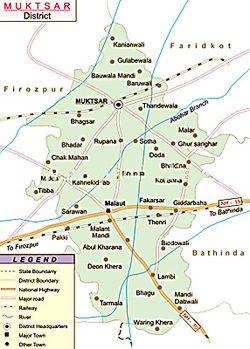
Muktsar is a city and a municipal council in Muktsar district in the Indian state of Punjab. Muktsar's old name was Khidrane dee dhab ( ਖਿਦਰਾਣੇ ਦੀ ਢਾਬ ). Situated at a distance of 45 Kms from faridkot and 50 Kms from Ferozepur, Muktsar is famous for its Sikh shrines. Muktsar also has a number of Gurudwaras such Tuttu Gandi Sahib, Tibbi Sahib, Tambu Sahib etc. which commemorate incidents from the life of Guru Gobind Singh ji. Gurudwara janamsthan Guru Angad Dev Ji and Gurudwara Chhateana Sahib are also situated in Muktsar District.
According to census of 2001, Muktsar has total population of 7,77,493. The percentage of rural population to the total population is 74.46% . Muktsar has population density of 297 persons per sq. Km compared to 484 persons per sq km of the Punjab, which is the lowest in Punjab. There are 891 women for every 1000 men in the district. The Scheduled Castes form 37.75% of the total population in this district. The population of Muktsar District has increased at the rate of 18.80% from 1991 to 2001 against 20.10% for the whole state.
The Maghi Mela ( ਮੇਲਾ ਮਾਘੀ ) held in the town of Muktsar, a day after Lohri (13 January) is very famous. Held every January it is to commemorate the valour of 40 Muktas, (or the liberated ones), who laid down their lives following Sri Guru Gobind Singh into the battle-field of Khidrana ( ਖਿਦਰਾਨੇ ਦੀ ਢਾਬ ). The huge Mela is held at an open space mainly on the Bathinda & Malout roads. People from all over the world, come to Muktsar on this day to take a dip in the holy sarovar. Traditionally a horse fair was also held on this occasion but it is not held anymore.
History of mukatsar
Muktsar has a proud heritage. It is known as the last battlefield of Guru Gobind Singh, which proved to be a most decisive conflict in the military history of the Sikhs. Literally the name of this city means "the pool of liberation". The forty Sikh warriors who fought to death here against the Mughal Empire more than three centuries ago are remembered by a grand festival held here every January, which attracts devotees from all over the world.
Guru Gobind Singh Ji, fought his last battle against Mughals in 1705 A.D. at Muktsar. During fighting, 40 disciples of Guru Ji know as ‘40 Muktas’ ( 40 liberated ones ) sacrificed their lives. These 40 Sikhs were those who insisted that Guru Ji should leave the Anandpur Sahib fort, when it was besieged by Mughal army. Guru Ji had than asked these followers to leave him if they so desired but they should give him in written that he is not their guru and they are not his Sikh i.e. followers. When these Sikhs returned to their homes in Majha territory of Punjab, they were not welcomed by family members as they had left the Guru at time of trouble. They were overcome by shame and not in a position to face Guru Gobind Singh Ji again. On learning that Guru Ji was in region of present Muktsar the 40 Sikhs lead by Bhai Mahan Singh and accompanied by Mai Bhago, an illustrious lady in Sikh history, left their homes to help him. At that time Mughal army was searching for Guru ji. A pitched battle was fought near a pond called Khidrane di Dhab. The 40 sikhs fought valiantly for guru ji and achieved martyrdom. The outcome was in favour of Sikhs. Mughal forces failed in capturing or harming Guru Sahib and fled from battle field. After the battle was over, Guru Ji visited the battle field. One of the 40 Sikhs, Sardar Mahan Singh was about to die, Guru Ji took his head in his arms and asked what did he want? Sardar Mahan Singh requested Guru Ji to tear the paper (Bedawa), they had given to him at Anandpur Sahib ‘you are not our guru and we are not your followers’. On this Guru Ji tore the bedawa . These 40 Sikhs were henceforth called 40 Muktas. The city that grew at the site of the battle was called Muktsar after them. Mela Maghi, a famous fair of Punjab, is celebrated at Muktsar on next day after Lohri every year as a tribute to those 40 Muktsar.
According to census of 2001, Muktsar has total population of 7,77,493. The percentage of rural population to the total population is 74.46% . Muktsar has population density of 297 persons per sq. Km compared to 484 persons per sq km of the Punjab, which is the lowest in Punjab. There are 891 women for every 1000 men in the district. The Scheduled Castes form 37.75% of the total population in this district. The population of Muktsar District has increased at the rate of 18.80% from 1991 to 2001 against 20.10% for the whole state.
The Maghi Mela ( ਮੇਲਾ ਮਾਘੀ ) held in the town of Muktsar, a day after Lohri (13 January) is very famous. Held every January it is to commemorate the valour of 40 Muktas, (or the liberated ones), who laid down their lives following Sri Guru Gobind Singh into the battle-field of Khidrana ( ਖਿਦਰਾਨੇ ਦੀ ਢਾਬ ). The huge Mela is held at an open space mainly on the Bathinda & Malout roads. People from all over the world, come to Muktsar on this day to take a dip in the holy sarovar. Traditionally a horse fair was also held on this occasion but it is not held anymore.
History of mukatsar
Muktsar has a proud heritage. It is known as the last battlefield of Guru Gobind Singh, which proved to be a most decisive conflict in the military history of the Sikhs. Literally the name of this city means "the pool of liberation". The forty Sikh warriors who fought to death here against the Mughal Empire more than three centuries ago are remembered by a grand festival held here every January, which attracts devotees from all over the world.
Guru Gobind Singh Ji, fought his last battle against Mughals in 1705 A.D. at Muktsar. During fighting, 40 disciples of Guru Ji know as ‘40 Muktas’ ( 40 liberated ones ) sacrificed their lives. These 40 Sikhs were those who insisted that Guru Ji should leave the Anandpur Sahib fort, when it was besieged by Mughal army. Guru Ji had than asked these followers to leave him if they so desired but they should give him in written that he is not their guru and they are not his Sikh i.e. followers. When these Sikhs returned to their homes in Majha territory of Punjab, they were not welcomed by family members as they had left the Guru at time of trouble. They were overcome by shame and not in a position to face Guru Gobind Singh Ji again. On learning that Guru Ji was in region of present Muktsar the 40 Sikhs lead by Bhai Mahan Singh and accompanied by Mai Bhago, an illustrious lady in Sikh history, left their homes to help him. At that time Mughal army was searching for Guru ji. A pitched battle was fought near a pond called Khidrane di Dhab. The 40 sikhs fought valiantly for guru ji and achieved martyrdom. The outcome was in favour of Sikhs. Mughal forces failed in capturing or harming Guru Sahib and fled from battle field. After the battle was over, Guru Ji visited the battle field. One of the 40 Sikhs, Sardar Mahan Singh was about to die, Guru Ji took his head in his arms and asked what did he want? Sardar Mahan Singh requested Guru Ji to tear the paper (Bedawa), they had given to him at Anandpur Sahib ‘you are not our guru and we are not your followers’. On this Guru Ji tore the bedawa . These 40 Sikhs were henceforth called 40 Muktas. The city that grew at the site of the battle was called Muktsar after them. Mela Maghi, a famous fair of Punjab, is celebrated at Muktsar on next day after Lohri every year as a tribute to those 40 Muktsar.
Shahid Bhagat singh nagar (Nawashaher)

Shahid Bhagat Singh Nagar district (Punjabi:ਸ਼ਹੀਦ ਭਗਤ ਸਿੰਘ ਨਗਰ ਜ਼ਿਲਾ), Hindi: शहीद भगत सिंह नगर ज़िला; formerly Nawanshahr district) is one of the districts in the state of Punjab in North-West Republic of India. It consists of two Sub -Divisions Nawanshahr and Balachaur. There are three legislative seats in the district, Nawanshahr, Balachaur and Banga. They fall under the Anandpur Sahib Lok Sabha Constituency.
History
Shaheed Bhagat Singh Nagar district was carved out of Hoshiarpur and Jalandhar districts of Punjab on November 7, 1995, as the sixteenth district of Punjab State named from the headquarters town of Nawanshahr. Nawanshahr town is said to have been built by an Afghan Military Chief, Nausher Khan. Previously it was called "Nausar" but with the passage of time, the town came to be known "The Nawanshahr". Nawanshahr has been the stronghold of the Ghorewaha Rajputs.
The Scheduled Caste population is more than 40%, one of the highest percentage in India.
Nawanshahr became the District in 1995 during S.Harcharan Brar Govt., with the strong efforts of Late S.Dilbag Singh, Former Cabinet Minister and the then MLA of Nawanshahr. People of this district are economically sound. Large numbers of families from the district have settled abroad. Consequently huge remittance is being received back in India which contributes to the district's economic development and prosperity. The prosperity of Doaba area can be appreciated by the fact that price of land here is sky-scraping and almost far more than most of the districts in the state except Ludhiana, and Chandigarh. Nawanshahr is rising due to the currency coming from NRI Punjabi people who have settled abroad. Nawanshahr also has a rail track connecting it with Jalandhar, Rahon and Jaijon.
This region has abundant health facilities. Here Private clinics and Nursing homes not only surprise with their numbers but also some of them claim to have latest medical equipments. There are adequate number of Government Hospitals, Dispensaries and Primary Health Centers in this area. The hospitals in Nawanshahr have capacity of 64 beds and are equipped with latest medical tools. Banga and Balachaur hospitals are having capacity of 30 beds each. Also Mukandpur, Urapar, Sujjon, Saroya and Muzzaffarpur are provided all kinds of health services. Even for every village of the district health services are available. Veterinary hospitals are available in Nawanshahr, Rahon, Saroya and Balachaur.
On September 27, 2008 at Khatkar Kalan, eight km from Nawanshahr, the Punjab government announced that a district in the state would be named after freedom fighter Bhagat Singh. The announcement was made by Punjab Chief Minister Parkash Singh Badal at the ancestral village of the Shahid Bhagat Singh to mark his 101st birth anniversary and Nawanshahr district was renamed Shahid Bhagat Singh Nagar.
History
Shaheed Bhagat Singh Nagar district was carved out of Hoshiarpur and Jalandhar districts of Punjab on November 7, 1995, as the sixteenth district of Punjab State named from the headquarters town of Nawanshahr. Nawanshahr town is said to have been built by an Afghan Military Chief, Nausher Khan. Previously it was called "Nausar" but with the passage of time, the town came to be known "The Nawanshahr". Nawanshahr has been the stronghold of the Ghorewaha Rajputs.
The Scheduled Caste population is more than 40%, one of the highest percentage in India.
Nawanshahr became the District in 1995 during S.Harcharan Brar Govt., with the strong efforts of Late S.Dilbag Singh, Former Cabinet Minister and the then MLA of Nawanshahr. People of this district are economically sound. Large numbers of families from the district have settled abroad. Consequently huge remittance is being received back in India which contributes to the district's economic development and prosperity. The prosperity of Doaba area can be appreciated by the fact that price of land here is sky-scraping and almost far more than most of the districts in the state except Ludhiana, and Chandigarh. Nawanshahr is rising due to the currency coming from NRI Punjabi people who have settled abroad. Nawanshahr also has a rail track connecting it with Jalandhar, Rahon and Jaijon.
This region has abundant health facilities. Here Private clinics and Nursing homes not only surprise with their numbers but also some of them claim to have latest medical equipments. There are adequate number of Government Hospitals, Dispensaries and Primary Health Centers in this area. The hospitals in Nawanshahr have capacity of 64 beds and are equipped with latest medical tools. Banga and Balachaur hospitals are having capacity of 30 beds each. Also Mukandpur, Urapar, Sujjon, Saroya and Muzzaffarpur are provided all kinds of health services. Even for every village of the district health services are available. Veterinary hospitals are available in Nawanshahr, Rahon, Saroya and Balachaur.
On September 27, 2008 at Khatkar Kalan, eight km from Nawanshahr, the Punjab government announced that a district in the state would be named after freedom fighter Bhagat Singh. The announcement was made by Punjab Chief Minister Parkash Singh Badal at the ancestral village of the Shahid Bhagat Singh to mark his 101st birth anniversary and Nawanshahr district was renamed Shahid Bhagat Singh Nagar.
Patiala
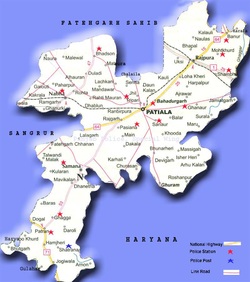
Patiala district is one of the erstwhile princely cities of Punjab. It is located in the south-eastern part of the state.
Patiala city is the administrative headquarters of Patiala District, and was the capital of the premier princely state in the former Punjab Province of British India, headed by the Sidhu dynasty. Patiala is famous for its pagri (traditional headgear), paranda (tasselled tag for braiding hair), peg (Patiala Peg - a double or large peg of whiskey), and Jutti (traditional Punjabi footwear).
Any serving of alcohol which is double than the normal serving, or unusually large, is referred to as the Patiala Peg. This term is understood in most parts of India. There are multiple stories behind this epithet, most related to the opulent and hedonistic lifestyle of one of the maharajas of Patiala - Maharaja Bhupinder Singh, who was a heavy drinker.
Patiala is home town of many eminent personalities like cricketers Navjot Sidhu, Mohinder Amarnath, Reetinder Sodhi, Bollywood Stars Jimmy Shregill, Om Puri, Punjabi Singers Gurdas Mann & Harbhajan Mann, Jet Airways Chairman Naresh Goyal & Sq Ldr Rakesh Sharma, the first Indian in space.
History
In 1763 Baba Ala Singh laid the foundation of the Patiala fort known as Qila Mubarak, around which the present city of Patiala developed. After the Third Battle of Panipat in 1761 in which the Marathas were defeated, the writ of the Afghans prevailed through out Punjab. It is at this stage that the rulers of Patiala began to acquire ensigns of royalty. Ahmad Shah Abdali bestowed upon Ala Singh furm and banner, and the title of Maharaja of Patiala. After his death, his grandson Amar Singh succeeded and received the title of Raja-I-Rajaan. He was also allowed to strike coins.
After forty years of ceaseless struggle with the Mughals, Afghans and Marathas the borders of the Patiala state witnessed the blazing trails of Ranjit Singh in the north and of the British in the east. Bestowed with the grit and instinct of survival, making the right choice at the right time the Raja of Patiala entered into a treaty with the British against Ranjit Singh in 1808, thus becoming collaborators in the empire building process of the British in the sub-continent of India. The British treated the rulers of Patiala, such as Karam Singh, Narinder Singh, Mahendra Singh, Rajinder Singh, Bhupinder Singh and Yadvindra Singh with respect and dignity.
Maharaja Bhupinder Singh (Reign - 1900 to 1938) gave Patiala a prominent place on the political map of India and in the field of international sports. This included his dog kennels and he and the Maharaja of Jind were equally interested in a range of dog breeds. His son Yadvendra Singh was the first Indian prince to sign the Instrument of Accession, thus facilitating the process of national integration after independence in 1947. In recognition of his services, he was appointed the Rajpramukh of the newly established state of Patiala and East Punjab States Union (PEPSU), from its founding in 1948 until its merger with Punjab in 1956. The downtown area of Patiala is Adalat Bazaar, which means 'the court corridor', because this was used as the administrative building by one of the caretakers, before the King had reached the age of majority. The Royal Family are Jatts of the Sidhu family.
Patiala city is the administrative headquarters of Patiala District, and was the capital of the premier princely state in the former Punjab Province of British India, headed by the Sidhu dynasty. Patiala is famous for its pagri (traditional headgear), paranda (tasselled tag for braiding hair), peg (Patiala Peg - a double or large peg of whiskey), and Jutti (traditional Punjabi footwear).
Any serving of alcohol which is double than the normal serving, or unusually large, is referred to as the Patiala Peg. This term is understood in most parts of India. There are multiple stories behind this epithet, most related to the opulent and hedonistic lifestyle of one of the maharajas of Patiala - Maharaja Bhupinder Singh, who was a heavy drinker.
Patiala is home town of many eminent personalities like cricketers Navjot Sidhu, Mohinder Amarnath, Reetinder Sodhi, Bollywood Stars Jimmy Shregill, Om Puri, Punjabi Singers Gurdas Mann & Harbhajan Mann, Jet Airways Chairman Naresh Goyal & Sq Ldr Rakesh Sharma, the first Indian in space.
History
In 1763 Baba Ala Singh laid the foundation of the Patiala fort known as Qila Mubarak, around which the present city of Patiala developed. After the Third Battle of Panipat in 1761 in which the Marathas were defeated, the writ of the Afghans prevailed through out Punjab. It is at this stage that the rulers of Patiala began to acquire ensigns of royalty. Ahmad Shah Abdali bestowed upon Ala Singh furm and banner, and the title of Maharaja of Patiala. After his death, his grandson Amar Singh succeeded and received the title of Raja-I-Rajaan. He was also allowed to strike coins.
After forty years of ceaseless struggle with the Mughals, Afghans and Marathas the borders of the Patiala state witnessed the blazing trails of Ranjit Singh in the north and of the British in the east. Bestowed with the grit and instinct of survival, making the right choice at the right time the Raja of Patiala entered into a treaty with the British against Ranjit Singh in 1808, thus becoming collaborators in the empire building process of the British in the sub-continent of India. The British treated the rulers of Patiala, such as Karam Singh, Narinder Singh, Mahendra Singh, Rajinder Singh, Bhupinder Singh and Yadvindra Singh with respect and dignity.
Maharaja Bhupinder Singh (Reign - 1900 to 1938) gave Patiala a prominent place on the political map of India and in the field of international sports. This included his dog kennels and he and the Maharaja of Jind were equally interested in a range of dog breeds. His son Yadvendra Singh was the first Indian prince to sign the Instrument of Accession, thus facilitating the process of national integration after independence in 1947. In recognition of his services, he was appointed the Rajpramukh of the newly established state of Patiala and East Punjab States Union (PEPSU), from its founding in 1948 until its merger with Punjab in 1956. The downtown area of Patiala is Adalat Bazaar, which means 'the court corridor', because this was used as the administrative building by one of the caretakers, before the King had reached the age of majority. The Royal Family are Jatts of the Sidhu family.
Rupnagar
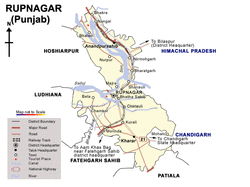
Rupnagar district (Doabi:ਰੂਪਨਗਰ ਜ਼ਿਲਾ) is one of the twenty districts in the state of Punjab in North-West Republic of India. The town of Rupnagar (formerly known as Rupar or Ropar) is said to have been founded by a Raja called Rokeshar, who ruled during the 11th century and named it after his son Rup Sen. It is also the site of an ancient town of the Indus Valley Civilization. The major cities in Ropar District are Morinda, Kurali, Anandpur Sahib. Morinda is also known as Baghawala "The City of Gardens." Morinda is located at Chandigarh-Ludhiana Highway.
History
The town of Rupnagar is of considerable antiquity. The town is said to have been founded by a Raja called Rokeshar who ruled in the 11th century and named Rupnagar after his son Rup Sen . The recent excavations carried out at Rupnagar have proved that this town was the seat of well developed Indus Valley Civilization . In proto - Historic Punjab perhaps Rupnagar is the only known excavation site which can claim the status of a small town or city . The founds in recent excavations consists of earthen bares, statues, coins, etc. That proves that the city dates back to Harrappa - Mohanjodharo civilization which crossed Satluj river. Many of them settled at this place. In the excavations many things founded belongs to Chandra Gupta, Kushan, Hoon and Mughal period. One of rare finds is a seal of Marble on which there are three letters engraved in Sindhi script. One of the finds is the statue of a woman dressing her hair. All these proves that even the people living in this town 4000 years, hence were fully civilized and well cultured.
Many historians are of the view that when the first man descended from the mountains in the North to plains, he settled down at Ropar. A Mount is still preserved by the Archeology Department at Ropar.
S. Hari Singh Rais of Sialba conquered Ropar in 1763 A.D. and established his state . His son Charat Singh made Ropar capital of the state .
After the fall of Sirhind in 1763, Rupnagar came under the sikhs Chief Hari Singh. The most famous ruler of Ropar state was Raja Bhup Singh , who fought in the anglo-sikhs war of 1945. on the side of Maharaja Dalip Singh, the minor successor of Maharaja Ranjit Singh , against the British. Consequently, after the victory of the British, Ropar state of Raja Bhup Singh was confiscated.
The history of Ropar district is in fact the war of Guru Gobind Singh Ji against Mughal tyranny, exploiters and social evils. It is here in this district at Sarsa Nangal that the great Guru parted with the family and proceeded to Chamkaur Sahib where two elder Sahibzadas laid down their lives fighting for truth and Guru Sahib left for Machhiwara on a constant struggle.
The other important historical place in this District is Kiratpur Sahib situated on the banks of the river Satluj. This town was established by 6th Guru Shri Guru Har Gobind Singh Ji after buying Land from Raja Tara Chand of Kehloor through Baba Gurditta Ji. It is said that Guru Nanak Dev Ji made a professy regarding the establishment of this place. It is here at this place that Guru Nanak Dev Ji met saint Buddan Shah in a Jungle. It is here in Sheeshmahal that Guru Hargobind Sahib stayed from Sammat 1691 till the end came. Shri Guru Har Rai Ji and Shri Guru Harikrishan Ji were also born at this place and they were blessed with Guru Gaddi at this place. It is here at Gurdwara Patalpuri Sahib that Sikhs from all over the world immerse the ashes after death. Even the Babhuti of Shri Hari Krishan Ji was brought form Delhi and established at this place. About a half-mile away form Kiratpur Sahib the Takia of Saint Buddan Shah is situated.
Anandpur Sahib, a historical town in this district was founded by 9th Guru of Sikhs Shri Guru Teg Bahadar Ji after buying Land in Village Makowal in 1723 A.D. It is at this place that the great 9th Guru performed perance to commemorate the gurudwara Bhaura Sahib built at Anandpur Sahib . It is also here at Anandpur Sahib that Kashmiri Pandits approached 9th Guru to save them from Mughal Tyranny. Acceding their request on the motivation of Guru Gobind Singh Ji , Shri Guru Teg Bahadar Ji left for Delhi to make Supreme Sacrifice. At Anandpur Sahib the great 10th Guru of Sikhs Shri Guru Gobind Singh Ji spent his early age . It is here that the great Guru mastered the use of arms in Kila Anandgarh Sahib.
Further it was at Anandpur Sahib in Rupnagar District that Shri Guru Gobind Singh Ji created Khalsa in 1699 on Baisakhi Day and brought about a cultural revolution. It was the most important landmark in the history of sikhs. The Khalsa created by Guru Gobind Singh Ji later on acquired the sovereign power of Punjab under Maharaja Ranjit Singh . The creation of Khalsa at Anandpur Sahib is the most important event not only in history of Rupnagar district, but also in the history of the sikhs and Punjab. Gurudwara Keshgarh Sahib at Anandpur Sahib still commemorates the memory of the historical event as Guru created Khalsa at this place.
Another most important landmark historic event had been added to the history of the district, when in April 1999, 300th Birth of Khalsa was celebrated at Anandpur Sahib. Besides lacs of people from all walks of life from all over of the world, heads, important religious, social, political and administrative personalities participated in the Tercentenary functions and paid obesance at Gurudwara Takhat Shri Keshgarh Sahib. Historic City of Anandpur Sahib has been developed as tourist center. Khalsa heritage Memorial complex is being constructed.
History
The town of Rupnagar is of considerable antiquity. The town is said to have been founded by a Raja called Rokeshar who ruled in the 11th century and named Rupnagar after his son Rup Sen . The recent excavations carried out at Rupnagar have proved that this town was the seat of well developed Indus Valley Civilization . In proto - Historic Punjab perhaps Rupnagar is the only known excavation site which can claim the status of a small town or city . The founds in recent excavations consists of earthen bares, statues, coins, etc. That proves that the city dates back to Harrappa - Mohanjodharo civilization which crossed Satluj river. Many of them settled at this place. In the excavations many things founded belongs to Chandra Gupta, Kushan, Hoon and Mughal period. One of rare finds is a seal of Marble on which there are three letters engraved in Sindhi script. One of the finds is the statue of a woman dressing her hair. All these proves that even the people living in this town 4000 years, hence were fully civilized and well cultured.
Many historians are of the view that when the first man descended from the mountains in the North to plains, he settled down at Ropar. A Mount is still preserved by the Archeology Department at Ropar.
S. Hari Singh Rais of Sialba conquered Ropar in 1763 A.D. and established his state . His son Charat Singh made Ropar capital of the state .
After the fall of Sirhind in 1763, Rupnagar came under the sikhs Chief Hari Singh. The most famous ruler of Ropar state was Raja Bhup Singh , who fought in the anglo-sikhs war of 1945. on the side of Maharaja Dalip Singh, the minor successor of Maharaja Ranjit Singh , against the British. Consequently, after the victory of the British, Ropar state of Raja Bhup Singh was confiscated.
The history of Ropar district is in fact the war of Guru Gobind Singh Ji against Mughal tyranny, exploiters and social evils. It is here in this district at Sarsa Nangal that the great Guru parted with the family and proceeded to Chamkaur Sahib where two elder Sahibzadas laid down their lives fighting for truth and Guru Sahib left for Machhiwara on a constant struggle.
The other important historical place in this District is Kiratpur Sahib situated on the banks of the river Satluj. This town was established by 6th Guru Shri Guru Har Gobind Singh Ji after buying Land from Raja Tara Chand of Kehloor through Baba Gurditta Ji. It is said that Guru Nanak Dev Ji made a professy regarding the establishment of this place. It is here at this place that Guru Nanak Dev Ji met saint Buddan Shah in a Jungle. It is here in Sheeshmahal that Guru Hargobind Sahib stayed from Sammat 1691 till the end came. Shri Guru Har Rai Ji and Shri Guru Harikrishan Ji were also born at this place and they were blessed with Guru Gaddi at this place. It is here at Gurdwara Patalpuri Sahib that Sikhs from all over the world immerse the ashes after death. Even the Babhuti of Shri Hari Krishan Ji was brought form Delhi and established at this place. About a half-mile away form Kiratpur Sahib the Takia of Saint Buddan Shah is situated.
Anandpur Sahib, a historical town in this district was founded by 9th Guru of Sikhs Shri Guru Teg Bahadar Ji after buying Land in Village Makowal in 1723 A.D. It is at this place that the great 9th Guru performed perance to commemorate the gurudwara Bhaura Sahib built at Anandpur Sahib . It is also here at Anandpur Sahib that Kashmiri Pandits approached 9th Guru to save them from Mughal Tyranny. Acceding their request on the motivation of Guru Gobind Singh Ji , Shri Guru Teg Bahadar Ji left for Delhi to make Supreme Sacrifice. At Anandpur Sahib the great 10th Guru of Sikhs Shri Guru Gobind Singh Ji spent his early age . It is here that the great Guru mastered the use of arms in Kila Anandgarh Sahib.
Further it was at Anandpur Sahib in Rupnagar District that Shri Guru Gobind Singh Ji created Khalsa in 1699 on Baisakhi Day and brought about a cultural revolution. It was the most important landmark in the history of sikhs. The Khalsa created by Guru Gobind Singh Ji later on acquired the sovereign power of Punjab under Maharaja Ranjit Singh . The creation of Khalsa at Anandpur Sahib is the most important event not only in history of Rupnagar district, but also in the history of the sikhs and Punjab. Gurudwara Keshgarh Sahib at Anandpur Sahib still commemorates the memory of the historical event as Guru created Khalsa at this place.
Another most important landmark historic event had been added to the history of the district, when in April 1999, 300th Birth of Khalsa was celebrated at Anandpur Sahib. Besides lacs of people from all walks of life from all over of the world, heads, important religious, social, political and administrative personalities participated in the Tercentenary functions and paid obesance at Gurudwara Takhat Shri Keshgarh Sahib. Historic City of Anandpur Sahib has been developed as tourist center. Khalsa heritage Memorial complex is being constructed.
Sangrur
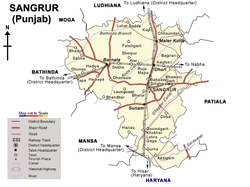
Sangrur district (Doabi:ਸਂਗਰੂਰ ਜ਼ਿਲਾ) is in the state of Punjab in North-West Republic of India. Earlier Barnala was part of Sangrur district, but now Barnala is a separate district.
The district of Sangrur was formed in 1948.The city sangrur is located at the intersection of the roads connecting Delhi with Ludhiana and Patiala with Bathinda, at a distance of 80 km from Ludhiana and 48 km from Patiala. The Ludhiana-Jakhal railway line passes through it. The Sangrur district is predominantly rural area in the southern part of Punjab.
History
The earliest settlement at the site of Sangrur is believed to have begun around 2,300 B.C. Attracted by the fertile soil and availability of water, people from Sind and Baluchistan started moving and following the path of the Satluj or the Ghagger settled at Rohira. They started living in thatched huts on the virgin soil, Before long they started building houses of sub-dried bricks. By about 2,000 B.C, a new set of people is believed to have settled at the site. Their pottery was more Surdy and their equipment superior. The houses were well laid out and were fairly spacious. Sangrur is said to have been founded by one Sanghu, a Jatt, about four hundred years back. The district of Sangrur was formed in 1948.
The district of Sangrur was formed in 1948.The city sangrur is located at the intersection of the roads connecting Delhi with Ludhiana and Patiala with Bathinda, at a distance of 80 km from Ludhiana and 48 km from Patiala. The Ludhiana-Jakhal railway line passes through it. The Sangrur district is predominantly rural area in the southern part of Punjab.
History
The earliest settlement at the site of Sangrur is believed to have begun around 2,300 B.C. Attracted by the fertile soil and availability of water, people from Sind and Baluchistan started moving and following the path of the Satluj or the Ghagger settled at Rohira. They started living in thatched huts on the virgin soil, Before long they started building houses of sub-dried bricks. By about 2,000 B.C, a new set of people is believed to have settled at the site. Their pottery was more Surdy and their equipment superior. The houses were well laid out and were fairly spacious. Sangrur is said to have been founded by one Sanghu, a Jatt, about four hundred years back. The district of Sangrur was formed in 1948.
Tarn Taran district

Tarn Taran district (Doabi:ਤਾਰਨ ਤਰਾਂ ਜ਼ਿਲਾ) is one of the districts in the state of Punjab in North-West Republic of India. Some of its main cities are Tarn Taran Sahib which is located near Amritsar and Patti, City of Taran Taran is a holy place for Sikhs of India and abroad.
Tarn Taran district was formed in 2006. The declaration to this effect was made by Captain Amarinder Singh, Ex-Chief Minister of Punjab, during the celebrations marking the martyrdom day of Sri Guru Arjan Dev Ji. With this, it became the 19th district of Punjab. It has three tehsils, which are Patti, Khadur Sahib and Tarn Taran. The District Headquarters is headed by the Deputy Commissioner, along with a Senior Superintendent of Police, the Additional District and Sessions Judge, the Chief Judicial Magistrate, Civil Surgeon, district Education Officer, Improvement Trust and a Municipal Council.
Tarn Taran district was formed in 2006. The declaration to this effect was made by Captain Amarinder Singh, Ex-Chief Minister of Punjab, during the celebrations marking the martyrdom day of Sri Guru Arjan Dev Ji. With this, it became the 19th district of Punjab. It has three tehsils, which are Patti, Khadur Sahib and Tarn Taran. The District Headquarters is headed by the Deputy Commissioner, along with a Senior Superintendent of Police, the Additional District and Sessions Judge, the Chief Judicial Magistrate, Civil Surgeon, district Education Officer, Improvement Trust and a Municipal Council.
